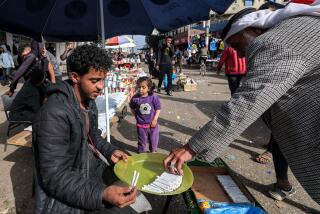Getting clean in an opiate den
- Share via
TEHRAN — The man in the mustard-colored blazer had a new haircut. It shined in the morning light as he stood near a strange, vulnerable collection of guys at the edge of a park, where murals of ayatollahs and martyrs floated above rooftops and gardeners lugged hoses to the sound of water fisch-fisch-fisching over cold green grass.
They asked God for courage to change what could be changed and wisdom enough to know what couldn’t be undone. It seemed like a good prayer, and the man closed his eyes and joined in for a moment. Then he cleared his throat and tried to gather the part of himself that he had somehow lost years ago.
“I’m a lodger in a small room,” Gholam Reza Akbarabadi said. “These men and I help each other. We talk about daily things -- like today, for example, I have temptation for alcohol and heroin. It’s hard. I overcome it by talking. I’ve been clean four months and 27 days.”
He ate a sugar cube and lit a cigarette. The other addicts in Narcotics Anonymous ended their prayer and poured tea, seeking solace from one another in this big, loud city beneath a mountain draped in snow.
“My wife is helping me to quit; she doesn’t reproach me so much anymore,” Akbarabadi said. “I think, maybe, my reputation will go up in the eyes of society. Society ignored us for years. I’ve been beaten and flogged in prison, but now society is seeing that I am a patient, not a criminal.”
Iran estimates that there are 2 million drug users in this rigidly conservative Shiite Muslim nation. International agencies put the number at more than 3 million. Facing one of the highest proportions of opiate addicts in the world, the Iranian government, which executes drug traffickers, has in recent years shown a degree of pragmatism and tolerance toward men such as Akbarabadi.
“The government has belatedly realized that using force and throwing people in jail won’t solve the drug epidemic or the problems of AIDS and hepatitis,” said Hussain Dojakam, a former addict with flowing white hair who directs the Human Regeneration Society, a counseling clinic for addicts. “Eighty percent of AIDS patients are addicts who picked it up by using dirty syringes in prison. The laws haven’t changed, but attitudes have.”
The government sponsors 200 centers around the country that distribute condoms, syringes and methadone. This seems an odd ripple of liberalism for a nation ruled by the Koran, but Tehran is also considering releasing thousands of addicts from prison and has begun testing an opium-based syrup to wean junkies off their fixes. Three months ago, it started distributing food coupons to addicts. This shift in attitude, Dojakam said, is propelled by a police force that over the years has gained a better understanding of the drug culture.
But the populist regime of President Mahmoud Ahmadinejad offers no comprehensive counseling programs or insurance plans to cover narcotics abuse. Addicts are often still treated as outcasts, part of a drug scene that has steadily widened from the middle-class hash and opium smokers in the days before the 1979 Islamic Revolution to today’s street-level crack and heroin users, many of them poor and unemployed in a repressive state that offers few options.
“Drug addiction is going up by a horrible rate,” said a doctor who runs a private detoxification clinic and asked not to be named for fear of retribution. “When I was young, in a village or a poor neighborhood you’d hear people say, ‘I know an addict.’ But now drugs are so pervasive, people say, ‘I know somebody who is not an addict.’ You criminalize beer, you criminalize girlfriends. You close everything to the young, but the young need a way open, an outlet. We doctors are so angry and frustrated at the government.”
Many of the drugs reaching Iran are transported across the harsh borderlands of Pakistan and Afghanistan, the world’s top opium producer. On a landscape of tribal clans and disparate militant Islamists, Iranian police and security forces battle drug lords. What bundles slipped through over the years reached the men in the park, the members of Narcotics Anonymous, one of many such groups started around the country to help addicts stop using drugs.
The men sat on yellow and red plastic chairs; beyond them women in black chadors worked out on outdoor exercise machines and men with satchels and briefcases rushed for taxis and buses. The addicts were quiet and moved slowly, like a jazz band awakened too early. They coughed and sucked on sugar cubes; the weaker-willed among them reached for cigarettes; a few shivered in the morning chill.
A young addict sat with an older one in the sun near a metal sculpture in the shape of a knot. The young addict, who gave his name only as Khosrou, was born after Ayatollah Ruhollah Khomeini swept to power in an Islamic revival that branded America as the Great Satan and banned alcohol, cigarettes and other pleasures. The older man, Saber Shabestarzadeh, 54, remembers the days before upheaval and theocratic indoctrination, when Iran had its own opium plantations and getting high was as easy as buying bread.
“I took up hash in the army when I was 19, and by 21 I was married,” Shabestarzadeh said. “My friends were all smoking opium, and they told me it would increase my sexual prowess, but the revolution came and the government started executing drug traffickers and opium got too expensive, but heroin was available.”
Shabestarzadeh -- the name is a mouthful even for Iranians -- has combed gray hair and tapered hands, not the kind one would expect from a retired mechanic. He dresses more like a jeweler; he is a grandfather with a junkie’s memories who feels respectable when he slips on his gray suit and fastens the polished belt buckle at his waist. Other addicts study him; perhaps, he is the other side of where they are.
“I kept on heroin until two years, eight months and seven days ago,” he said. “I was so heavy a user that I’d even take diarrhea pills if I didn’t have heroin. I poisoned my body.”
He pulled out an identification card, a picture taken long ago, the kind of photograph a man sees the best of himself in and hopes others see it too. Life does not grant many of those images, and Shabestarzadeh has kept his carefully preserved: a strong young man with a swoop of dark hair and a mustache as lush as a foxtail.
Khosrou’s hair is dark too. Mussed and spiky, it seems to endure a perpetual windstorm and is the style of many men here, a quiet defiance of a government that attempts to suppress the fashion and allure of the West. Khosrou is 26 and has been an addict for five years, starting when he was in the army and carrying on to university, where he studied graphic arts. He’s been clean for four months and 20 days.
He knows the tempting and at times perilous fluctuations of the marketplace. Dealers are promoting this new thing called “ice,” a dangerous mix of amphetamines, and have dropped the price per gram from $160 to $100, but the quality is lower than months ago. Heroin-based crack with a hint of codeine has dropped from $50 per gram to $10, another attempt at increasing the market with a less pure and often contaminated drug. The addicts say crack is also smuggled across Africa by camels that are forced to swallow the drugs and are later killed and gutted so the supply can be ferried into Central Asia.
“I needed to get over my crack habit,” Khosrou said. “I went to a garden and spent 19 days there alone. I was in pain, but I got over it. It was heroic.”
Akbarabadi knew it was going to be a long day; he was already talking about temptation before the sun rose over the tall buildings. His wife and two children live 13 hours away in Shiraz. He doesn’t see them much. He spends his hours shining shoes; 40 cents a pair, mending soles for a bit more.
“I want to go back to my family. I send them money, but I want to go back and I can’t,” he said. “I’ve been out of jail for three years. I picked up a skin disease there, a strange parasite got under my skin, making tunnels in me.”
He lit another cigarette, brushed ash from his blazer. His words flowed insistently but in no great hurry. Soon, he would carry his shoeshine box over the sidewalks, stopping at corners and in front of offices and stores, a man with a rag and a smile.
“I think, overall,” he said, “out of 100 addicts, only four will succeed.”
The group of men split up. They followed different paths out of the park, staying in twos and threes until they went their own ways across the city.
--
jeffrey.fleishman @latimes.com
More to Read
Sign up for Essential California
The most important California stories and recommendations in your inbox every morning.
You may occasionally receive promotional content from the Los Angeles Times.











